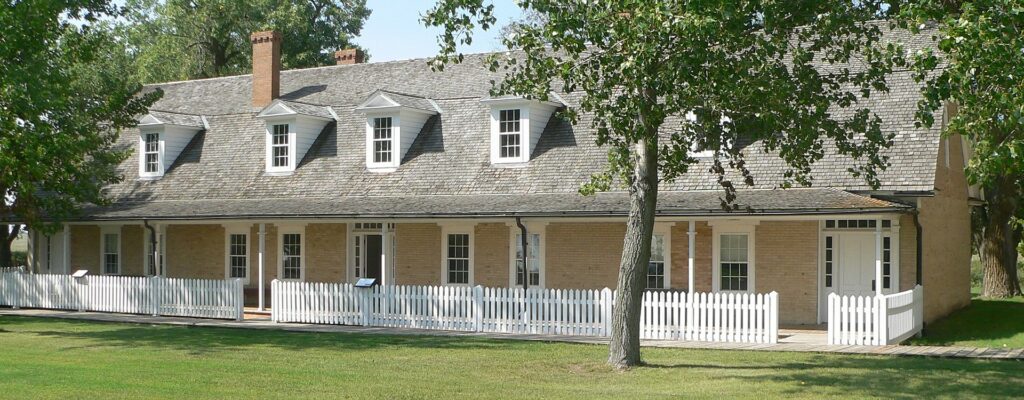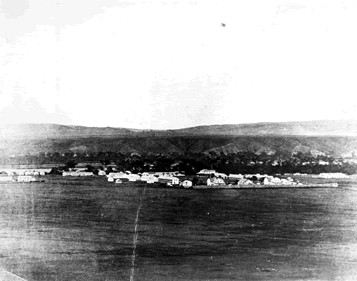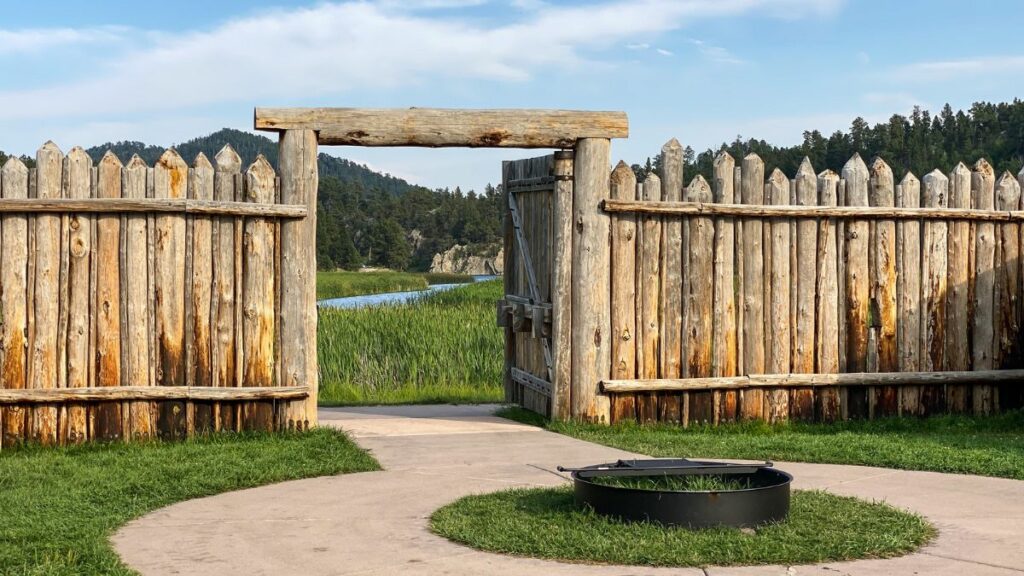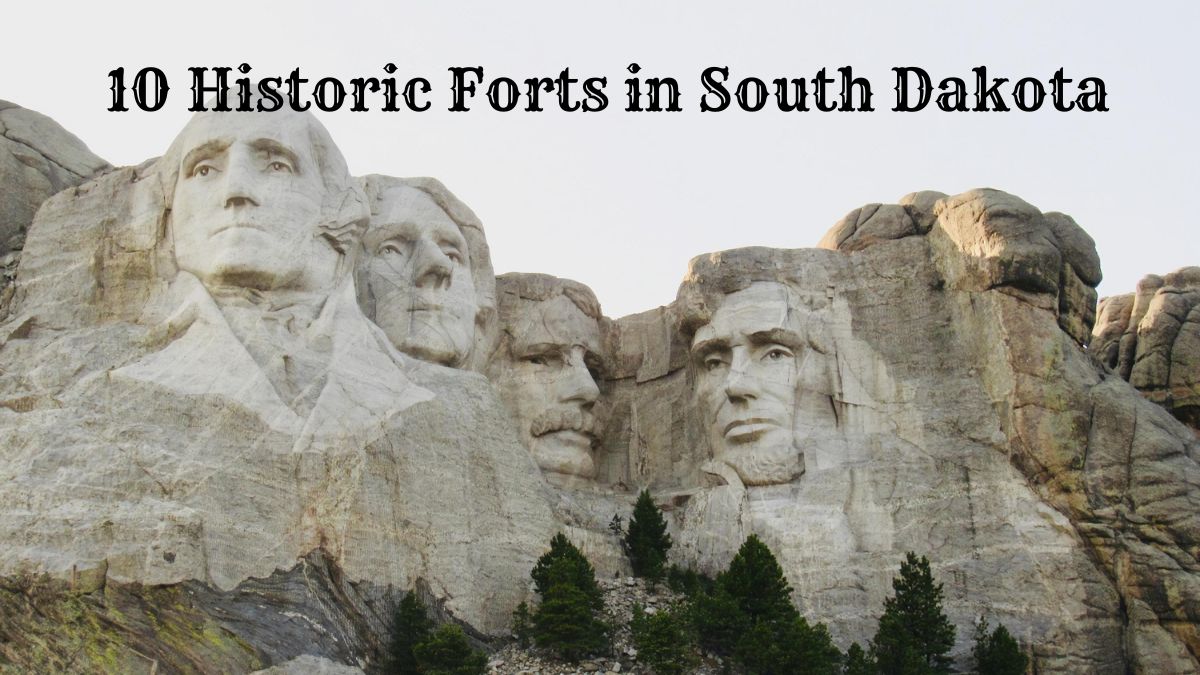The vast expanse of South Dakota has long held strategic importance in the tapestry of the United States’ past. This significance has been marked by numerous forts, serving as reminders of a time when the northern plains were the frontlines of expansion, trade, and conflict.
The Missouri River, a serpentine landmark, has always been a focal point in shaping the history of the northern plains.
Its banks saw the earliest settlements, and soon, the Dakota Territory emerged as a critical region. Historic forts in South Dakota sprouted along its length, ensuring dominance and control.
These military outposts weren’t just about dominance; they were the pillars of safe passage for white settlers. They also morphed into trading posts, fostering relationships and sometimes conflicts with fur traders and American Indians.
Historic Forts in South Dakota
| 1. Post at Grand River Indian Agency | 6. Fort Pierre Chouteau |
| 2. Camp Crook | 7. Fort Dakota |
| 3. Fort Outlook | 8. Fort Bennett |
| 4. Fort Meade | 9. Fort Randall |
| 5. Fort Sisseton | 10. Gordon Stockade |
1. Post at Grand River Indian Agency
The Post at Grand River Indian Agency was established in the latter half of the 19th century, near present-day Mobridge in South Dakota.
Its primary role was to serve as a governmental outpost for administrating and overseeing affairs related to Native American tribes, particularly the Lakota Sioux, in the region.
The Grand River Indian Agency was not just a physical structure but a hub of diplomatic interactions between the U.S. government and indigenous populations.
Officials at the post facilitated negotiations, managed treaties, and oversaw the implementation of government policies concerning the Native tribes.
Trade and Resource Distribution
Beyond diplomacy, the post also significantly impacted trade and resource distribution. As part of the reservation system, the agency was responsible for distributing annuities, supplies, and rations to the tribes as stipulated in various treaties.
This role made it a focal point for economic activity and tensions arising from delayed or inadequate distributions.
Architectural Layout and Significance
While its primary functions were administrative and diplomatic, the post was built to ensure the safety and functionality of its operations. This meant incorporating office spaces, storage areas for supplies and goods, residential quarters for officials, and some defensive features to address potential threats.
Challenges and Contentions
Given the broader backdrop of the Indian Wars and frequent policy shifts, the Grand River Indian Agency often found itself at the center of tensions. Disputes over treaty rights, land encroachments, and resource distributions were common, making the post’s role both essential and challenging.
Legacy and Contemporary Relevance
Though the Post at Grand River Indian Agency is no longer active, its historical significance remains. It is a testament to the U.S. government’s interactions with Native American tribes during a profound change and upheaval period.
Today, markers and preserved sections of the post provide insights into the complexities of frontier diplomacy, trade, and the myriad challenges faced during American history.
2. Camp Crook

Once Situated in Pennington County, South Dakota, Pactola, originally known as Camp Crook, thrived from 1875 until the early 1950s. Initially emerging as a placer mining hub, its history took a turn when the town found itself underwater, becoming part of Pactola Lake.
From Camp Crook to Pactola
The town initially bore the name “Camp Crook,” a tribute to General George Crook, whose headquarters took root in the town. However, in 1878, seeking a more captivating moniker, lawyer and journalist H. N. Maguire prompted the miners to adopt the name “Pactola.”
This new title was inspired by the ancient Greek placer mining along the Pactolus River, located in the historic region of Lydia.
A Turbulent Past
July 1875 saw the establishment of the Rapid City Mining District. Intriguingly, the Black Hills were, at the time, Lakota territory.
Miners named their new settlement “Camp Crook,” ironically hiding from the very person it was named after, General Crook.
Their cover was blown by August 1875, leading to their eviction from the Black Hills. Subsequently, General Crook utilized the town as his base, driving out miners who were breaching the Treaty of Fort Laramie.
By February 1876, the hills reopened, leading to a rush of miners staking claims along the river, some of which fetched a staggering $50,000.
A blizzard in March found 80 men, led by James C. Sherman, stranded in the town. Sensing the lure of gold, Sherman opted to remain.
Pactola’s Heyday and Decline
By late 1876, Pactola was in its prime, home to approximately 300 miners. A store opened its doors that same year and the Black Hills & Western Railroad went to Pactola.
A year later, the region witnessed the establishment of one of its earliest post offices. James C. Sherman made a mark again, founding the Sherman House, the Black Hills’ premier hotel. Serving dual purposes, this hotel also functioned as a stage station for two distinct stage lines.
Despite its early successes, Pactola faced challenges. Numerous attempts to extend the town’s flumes and ditches to the creek proved too costly.
Over time, the once-bustling town witnessed a decline in population and activity. By the time it met its watery fate, only a handful of its original structures remained, complemented by newer constructions like a lodge and a store.
The Submersion of a Town
Pactola’s final chapter was written in the early 1950s when the advancing waters of Pactola Lake consumed the town. Remarkably, a lone cabin resisted the encroaching waters, now standing as a silent witness downstream of the lake.
3. Fort Outlook
Strategically nestled by the Missouri River, Fort Lookout’s location was no coincidence.
The river, an essential lifeline for transportation, trade, and communication, made the fort’s position invaluable. Its proximity to the river ensured easy access to resources and quick communication with other outposts.
Role in the U.S.-Dakota War
During the U.S.-Dakota War, Fort Lookout stood as a silent yet potent guardian.
As tensions between the Dakota (Sioux) tribes and the U.S. settlers escalated, the fort was crucial in providing safety and coordination for military endeavors.
Its stronghold status made it a reliable base for operations, strategizing, and troop rest.
The Fort’s Advantageous Design
Being a vantage point was not merely a namesake for Fort Lookout.
The design and location of the fort offered unparalleled views of the surrounding landscape, allowing for early detection of approaching forces or potential threats.
This early-warning capability and its military robustness made it an essential asset during conflicts.
Architectural Merits
Built to withstand the challenges of warfare and the elements, Fort Lookout showcased the architectural prowess of its time. Its design balanced fortification for defense and functional spaces for daily military activities.
Legacy and Preservation
Even though Fort Lookout may not be as vocally celebrated as other military outposts, its contribution to the U.S.-Dakota War and the safety of the region’s settlers is undeniable.
Efforts have been made over the years to preserve the fort’s integrity, ensuring that future generations can appreciate its historical significance.
Modern Interpretation
Today, Fort Lookout symbolizes the complex interactions between Native American tribes and the advancing frontiers of U.S. settlement.
For those interested in the intricate web of American history, the fort offers a tangible connection to the past, illustrating the challenges, strategies, and sacrifices of the U.S.-Dakota War era.
4. Fort Meade

Fort Meade enjoys a unique geographical advantage near Sturgis, South Dakota. Sturgis, now renowned for its annual motorcycle rally, boasts a rich history, and its proximity to Fort Meade further enhances the region’s historical tapestry.
Fort Meade was established in the late 19th century, originally designed to protect the new settlements in the northern Black Hills, especially those emerging from the Gold Rush.
Over the years, it was pivotal in various regional conflicts and interactions with Native American tribes.
Connection to the Star Spangled Banner
One of the most intriguing facets of Fort Meade’s history is its connection to the Star Spangled Banner, the United States national anthem.
The fort was home to the 7th Cavalry band, which, in 1892, became one of the first to play the national anthem at the official flag-raising ceremony.
This set a precedent, and eventually, the tradition of playing the Star Spangled Banner at military and public events spread throughout the nation.
Architectural Insights
Fort Meade’s architectural layout reflects the defensive needs of its time while accommodating the soldiers’ daily lives.
Its design, materials, and structure are a testament to the architectural and military strategies of the late 19th and early 20th centuries.
Legacy and Conservation
Over the decades, Fort Meade has transformed from an active military outpost to a historical landmark.
Efforts to preserve its legacy, including its unique tie to the Star Spangled Banner, have been ongoing, ensuring the fort remains a vital link to the nation’s past.
Fort Meade is on the National Register of Historic Places.
Contemporary Significance
Today, Fort Meade stands not only as a reminder of South Dakota’s military and frontier history but also as a symbol of national pride and unity.
Its association with the Star Spangled Banner makes it a focal point for understanding the evolution of patriotic traditions in the U.S. Visitors, history enthusiasts, and patriots alike can journey to the fort to delve deeper into the intertwining stories of military history and national identity.
5. Fort Sisseton

Situated near Lake City, Fort Sisseton Historic State Park occupies a scenic expanse that offers natural beauty and a rich tapestry of history. The surrounding landscapes and the fort’s historic structures provide a vivid snapshot of the past.
Established in the 19th century, Fort Sisseton was crucial during frontier expansion and interactions with Native American tribes. It was a vital military outpost that maintained peace and facilitated westward movement.
Restoration by the Works Progress Administration (WPA)
Like many historical structures, the fort faced the wear and tear of time. But in the 20th century, under the auspices of the New Deal, the Works Progress Administration (WPA) embarked on a significant restoration project at Fort Sisseton.
This initiative was part of a broader national effort to provide jobs during the Great Depression while preserving America’s historical and cultural landmarks.
The WPA’s skilled laborers and craftsmen painstakingly revitalized the fort, ensuring its architectural integrity and historical significance were preserved for future generations.
Architectural Significance
The buildings within Fort Sisseton Historic State Park represent the military architecture of their era.
Made resilient by their original design and the WPA’s restoration efforts, they stand as testimonials to the architectural and engineering prowess of the times.
The Park
Today, Fort Sisseton Historic State Park is more than just a historical site; it’s a nexus of education, recreation, and reflection.
The park draws visitors from all over, allowing them to explore the fort’s buildings, engage in interactive historical displays, and enjoy the serene natural beauty of the surrounding area.
Enduring Legacy
Fort Sisseton’s legacy, enhanced by its restoration under the WPA, continues to impact contemporary society.
It serves as a poignant reminder of America’s frontier history, the country’s commitment to preserving its past, and the resilience and adaptability of its people during challenging times.
Visitors to the park step back in time and gain insights into the broader narrative of American history and progress.
6. Fort Pierre Chouteau

Established by the American Fur Company in 1832, Fort Pierre Chouteau was strategically situated in South Dakota.
Built under the guidance of influential fur trader John Jacob Astor’s company, it was crafted to tap into the burgeoning opportunities for trade with the Native American tribes and the flood of westward-moving settlers.
Decades of Dominance
From its establishment in 1832 until its sale to the U.S. Army in 1855, Fort Pierre Chouteau enjoyed prominence as a central trading nexus.
Over these two decades, the fort’s influence in regional trade was unrivaled, making it a bustling hub of commerce, culture, and negotiation.
Architectural Highlights
Fort Pierre Chouteau’s structures were built for three purposes: durability against the region’s harsh climatic conditions and efficient trade facilitation.
The fort’s design allowed for the secure storage of goods, from valuable furs to essential supplies, while providing spaces for trade discussions and negotiations.
Central Role in Regional Affairs
Beyond its commercial significance, Fort Pierre Chouteau played an instrumental role in the region’s sociopolitical intricacies during its operational years.
Serving as a nexus for tribal leaders, traders, and government representatives, it witnessed alliances, treaties, and the dynamic interplay of various cultural influences.
Transition and Legacy
By 1855, the trading dynamics began to shift, leading to the fort’s sale to the U.S. Army.
Its days as a commercial behemoth might have been numbered, but the legacy of its contributions to the region’s history remained undiminished.
Contemporary Significance
Today, the relics of Fort Pierre Chouteau transport visitors back to the 1830s and 1840s, when the American West underwent a profound transformation.
The fort is a monument to its past grandeur and a window into the intricate tapestry of commerce, diplomacy, and expansion that defined its operational years.
7. Fort Dakota
Situated by the strategic expanse of the Big Sioux River, Fort Dakota was erected in 1865 during a time of increasing westward expansion and frontier challenges.
Its establishment was an integral part of the military’s efforts to ensure the safety of settlers in the burgeoning city of Sioux Falls and its surroundings.
Role in the Development of Sioux Falls
While its primary mission was to protect settlers from potential conflicts with Native American tribes, Fort Dakota played a pivotal role in the growth and development of Sioux Falls.
Military fortification provided a sense of security that encouraged more settlers to make the area their home, facilitating the city’s growth in population and economic significance.
Architectural and Strategic Significance
Built alongside the Big Sioux River, Fort Dakota’s architecture was tailored to harness the river’s natural defensive advantage while facilitating its logistical operations.
The fort’s design catered to defense and the soldiers’ day-to-day needs.
Interaction with Native Tribes
Throughout its operational years, Fort Dakota was central to the interactions between settlers and Native American tribes.
While it stood as a protective barrier for the settlers, it also served as a point of negotiation and diplomacy, striving to balance the rights and concerns of the indigenous tribes with the aspirations of westward-moving settlers.
Decommissioning and Historical Legacy
Although Fort Dakota was decommissioned in 1869, its influence on Sioux Falls and the broader region endured. The area where the fort once stood continued to thrive and evolve, eventually becoming an integral part of modern Sioux Falls.
Modern Echoes
Today, Fort Dakota is a poignant reminder of Sioux Falls’ early days, challenges, and aspirations.
As visitors traverse the city, the fort’s legacy, reflected in historical markers and preserved remnants, offers a deep dive into the rich tapestry of Sioux Falls’ history, its interactions with Native American tribes, and its journey from a frontier settlement to a bustling city.
8. Fort Bennett
Established in 1870, Fort Bennett is located on the western banks of the Missouri River in present-day South Dakota.
Designed to be a safeguard during the tumultuous times of westward expansion, the fort played a role in the broader military strategy of the U.S. government to secure its frontiers and foster peaceful relations with indigenous populations.
Role in Westward Expansion
As settlers pushed westward, the need for military outposts like Fort Bennett became evident.
The fort acted as a protective buffer for settlers, ensuring their safety from potential conflicts and serving as a base for exploration and expeditions further into the West.
Architectural and Strategic Layout
Constructed to withstand the demands of its environment and the potential threats of its time, Fort Bennett’s architecture balanced functionality and defense.
Its design incorporated barracks, watchtowers, and other essential military facilities, all strategically positioned to maximize the fort’s defensive capabilities.
Interactions with Native Tribes
Fort Bennett was more than just a military installation; it became a center of interaction and negotiation between the U.S. Army and Native American tribes of the region.
Through formal and informal channels, the fort aimed to ensure peaceful coexistence and resolve disputes due to westward expansion.
The Fort’s Decline and Legacy
By the late 19th century, as the frontier became more settled and the immediate need for military installations like Fort Bennett decreased, the fort was eventually decommissioned.
However, its role in shaping the region’s history was firmly imprinted.
Today’s Significance
While Fort Bennett itself no longer stands, its legacy persists. Historical markers and records shed light on their role in shaping the American West.
For historians and visitors alike, the story of Fort Bennett offers a glimpse into the challenges, strategies, and nuances of frontier life during one of America’s most transformative epochs.
9. Fort Randall

Constructed in 1856, Fort Randall was strategically situated on the banks of the Missouri River in present-day South Dakota.
Designed as part of the military’s broader strategy to protect settlers and ensure peace on the American frontier, its location allowed it to oversee one of the region’s most vital waterways.
Guardian of the Frontier
In its prime, Fort Randall played a crucial role in protecting American settlers during their westward expansion.
It also served as a staging point for military expeditions and campaigns, notably during the Indian Wars, ensuring the U.S. government’s interests and security in the region.
Architectural and Defensive Design
Built to endure and defend, Fort Randall’s infrastructure boasted a robust construction with barracks, armories, and fortified walls.
Its placement along the Missouri River facilitated logistics and communication, providing a natural defensive advantage.
Interactions with Native American Tribes
Throughout its operational years, Fort Randall was a focal point for relations between the U.S. military and the region’s Native American tribes. It functioned as a place for treaties, negotiations, and sometimes conflicts.
The fort’s presence influenced the region’s dynamics, aiming to balance the U.S. government’s policies with the rights and concerns of indigenous peoples.
Waning Importance and Decommissioning
As the 19th century drew to a close, the need for frontier forts like Fort Randall diminished.
The fort’s importance declined as the frontier was considered “closed” and the region became more settled. It was officially decommissioned in 1892, marking the end of its active role in frontier history.
Today’s Tribute to the Past
While Fort Randall’s active days are long past, its legacy remains. The nearby Fort Randall Dam and the reservoir it created, Lake Francis Case, are modern reminders of the region’s history.
Today, visitors can explore the remnants of the fort, historical markers, and associated sites to delve into a pivotal chapter of American westward expansion and the complex interactions between settlers and Native American tribes.
10. Gordon Stockade

Amidst the backdrop of the 1874 Black Hills Gold Rush, Gordon Stockade was hastily erected as a defensive fortification.
Located in the Custer area of present-day South Dakota, this structure was primarily built by a group of gold seekers led by Captain Willard Gordon. They aimed to stake a claim and protect their interests against potential threats.
Symbol of the Gold Rush
The construction of the fence directly responded to the overwhelming influx of miners and settlers drawn to the Black Hills by the allure of gold. Gordon Stockade quickly symbolized this transformative gold rush period’s enthusiasm, ambition, and challenges.
Design and Features
Given the urgency of its purpose, Gordon Stockade was primarily built using available timber. Its design was simple yet effective, consisting of tall wooden walls with lookout posts.
Though not as elaborate as many military installations, the fence was a practical solution to the immediate needs of its inhabitants.
Friction and Frontier Challenges
Positioned in territory considered sacred to the Lakota Sioux and established without U.S. government sanction, Gordon Stockade became a focal point of tension.
Its existence manifested settler ambition and highlighted the broader conflicts over land rights and resources in the region.
Short-lived Yet Significant
Gordon Stockade’s active period was brief. Less than a year after its establishment, in the summer of 1875, the U.S. military evacuated its inhabitants, deeming the fortification illegal.
However, its short existence was enough to etch it into the annals of Black Hills’ history.
Present-Day Remembrance
Today, the reconstructed Gordon Stockade stands within Custer State Park, a tangible reminder of the Black Hills Gold Rush.
Visitors can explore the site, immersing themselves in the rich history of gold-seeking ambition, frontier challenges, and the complexities of American westward expansion.
Related: 10 Historic Forts in Texas
Engagement with Native Americans
Sacred Grounds: The Black Hills and Sioux Falls
The Black Hills and Sioux Falls aren’t just geographical landmarks; they hold profound spiritual significance for the Lakota people, one of the indigenous tribes of the Great Plains.
For the Lakota, the Black Hills, or “Paha Sapa,” is considered the heart of everything that is.
This sacredness is deeply rooted in the Lakota creation story, underscoring their connection to the land. Similarly, with its cascading waters and serene landscapes, Sioux Falls is seen as a point of reverence and connection to the ancestors.
The Dual Perspective of Forts
As settlers moved westward, they built forts to safeguard themselves from perceived threats, serve as trading hubs, and solidify their presence.
For many, these forts were symbols of hope, safety, and progress. However, these structures often represented a different story to the indigenous peoples who had lived on these lands for millennia.
To the Native Americans, particularly the Plains tribes like the Lakota, Cheyenne, and Arapaho, these forts embodied encroachment.
They stood as stark reminders of a life being pushed aside, treaties broken, and a sacred connection to the land being undermined.
These forts weren’t just physical barriers; they were symbols of the massive cultural and societal shifts displacing them.
The Wounded Knee Massacre: A Dark Chapter
One of the most harrowing episodes of the clash between Native Americans and the U.S. government occurred near Wounded Knee Creek in South Dakota in 1890.
The Wounded Knee Massacre resulted in the deaths of an estimated 150 to 300 Lakota Sioux, many of whom were women and children.
The incident began as an attempt by the U.S. 7th Cavalry Regiment to disarm a group of Lakota.
The tension escalated when a deaf tribesman reportedly didn’t want to give up his rifle because he had paid a lot for it. It’s unclear from which side a shot was fired, and the cavalry opened fire on the unarmed Lakota.
The Wounded Knee Massacre wasn’t just an isolated event. It culminated years of policies to suppress and displace the Native American population.
It signified the end of the Indian Wars and symbolized the depth of misunderstanding and mistrust between the two cultures.
Related: 10 Historic Forts in Utah
Conclusion – Historic Forts in South Dakota
As we stand on the hills of the prairies, the shadows of these forts remind us of South Dakota’s multifaceted history. They echo tales of trade, military strategy, and the grit of early settlers.
They also evoke stories of the Native Americans, whose lives were forever altered by these stone and wood structures.
So, the next time you’re gazing at Mount Rushmore National Memorial, remember that South Dakota’s history isn’t just carved in stone—it’s also etched in the remnants of forts that dot its picturesque landscape.
If you have visited any of these forts in South Dakota, we would love to hear about your experience in the comment section below.

Cory is a website owner and content creator who enjoys fishing, history, coin collecting, and sports, among other hobbies. He is a husband and father of four.
Romans 15:4 For whatever was written in former days was written for our instruction, that through endurance and through the encouragement of the Scriptures we might have hope.

